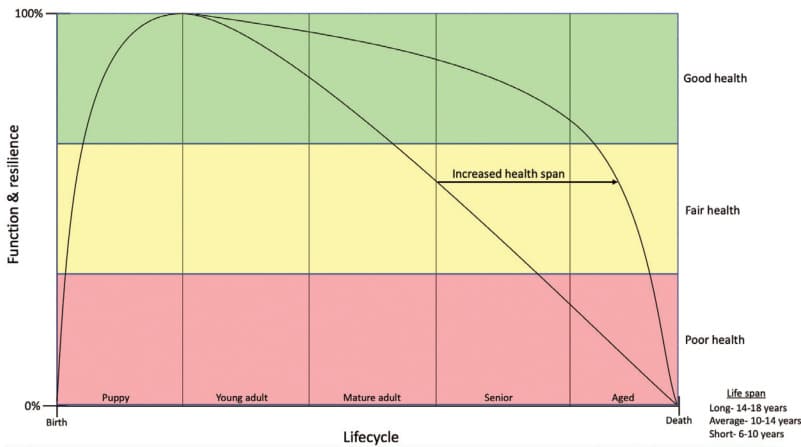I. Physical Changes and Exercise Needs of Older Dogs
As dogs enter old age (after about 11 years for small dogs, 9 years for medium-sized dogs, and 7 years for large dogs), there is a significant decline in physical function: joint wear and tear leads to an elevated risk of arthritis (which affects about 80 per cent of older dogs), a loss of muscle mass may trigger slower movement, declining cardiorespiratory fitness diminishes endurance, and cognitive deterioration may make them less interested in activities.!! At this point, moderate and safe exercise not only maintains muscle and joint flexibility, but also slows cognitive decline and even extends life.

Scientific Basis:
The Lifecycle Curve shows that older dogs are at their lowest point of ‘function and resilience’ and need exercise to slow down the rate of decline.
Studies have shown that regular low-impact exercise improves circulation and digestion and reduces anxiety in older dogs.
Muscle maintenance (resistance training) reduces the risk of falls and supports weak joints.
II. Six Types of Exercise Suitable for Older Dogs
1 .Short Walks: The Most Basic and Safe Exercise
Frequency: 10-15 minutes 2-3 times a day to avoid overdoing it in a single session.
Route Selection: Prioritise flat, familiar paths to reduce the stress of sudden distractions (e.g. traffic) on older dogs with deteriorating senses.

Effects: Promotes joint lubrication, stimulates olfactory exploration, and maintains basal metabolism.
2. WATER EXERCISE: IDEAL FOR JOINT FRIENDSHIP
SWIMMING: Buoyancy reduces the burden on joints and is suitable for dogs with arthritis. Recommended to be done in a heated pool or calm water, supervised throughout to prevent choking.
Aqua Treadmill: Commonly used in rehabilitation centres, it gently exercises muscles through the resistance of water currents and is especially suitable for post-operative recovery.
3. Mind games: activate the brain and slow down cognitive decline
Food puzzle toys: Hiding snacks in rollable toys encourages dogs to use their paws or noses to get them, stimulating problem-solving skills.
Sniffing game: Hide healthy snacks at home or on the patio and let your dog ‘hunt’ for them by sniffing for them, a combination of mental and physical activities.
4. Balance and Flexibility Training: The Key to Preventing Falls
Three Leg Standing Exercise: Gently lift one of your dog’s legs and encourage him to use all three legs to maintain balance for 3-5 seconds, repeat for 3 sets.
Customised Obstacle Course: Set up simple routes with soft mats, low tunnels, etc. to improve coordination.
5. Resistance Training: Gentle Muscle Strengthening
Hill Climbing Exercise: Walking on gentle slopes can enhance the strength of the hind limbs, but the gradient needs to be less than 10 degrees.
Weight-bearing vest: use light counterweights (no more than 5% of body weight) under the guidance of a veterinarian to slow down muscle loss.
6. nteractive activities: both emotional and health care
Soft ball tossing: silicone material is used to avoid dental injuries and is performed at a slow pace.
Massage and Stretching: Gently rub shoulders, neck and back legs after exercise to help relax tight muscles.
III. Exercise Safety and Precautions
1 .Individualised Adjustment
Dogs suffering from heart disease or respiratory disease need to shorten the exercise time, while overweight dogs should gradually lose weight through dietary control and low-intensity exercise.
2. Environmental and Climate Management
Avoid extreme weather: choose early morning/evening in summer, wear warm clothes and shorten outdoor time in winter.
Indoor alternatives: food distribution toys or maze mats can be used to provide activity on rainy and snowy days.
3. Health Monitoring and Medical Support
Periodic Physical Examination: Check your joints, heart and teeth every 6 months to make timely adjustments to your exercise programme.
Pain Signal Recognition: If your dog develops lameness, wheezing or loss of appetite after exercise, you need to pause the activity and seek medical attention.
IV. Nutrition and Rehabilitation: The Golden Partner of Exercise
1 .Dietary Strengthening of Muscles and Joints
High Protein and Low Fat Formulas: Choose senior dog food with glucosamine and Omega-3 to support joint health.
Antioxidant supplementation: Vitamin E, alpha-lipoic acid, etc. can slow down cellular aging, and these ingredients have been added to some professional foods.
2. Physical Therapy Supplement
Hydrotherapy & Hot Packs: relieves chronic pain and enhances exercise comfort.
Customised Rehabilitation Programmes: Veterinarians may recommend a combination of laser therapy or acupuncture to optimise the effects of exercise.
V. Psychological care: elements of health that go beyond the physical
Elderly dogs may suffer from anxiety due to sensory deterioration (e.g. blindness, deafness) **Emotional interactions during exercise** are crucial:
Maintaining patience: Allow the dog to explore at its own pace and avoid rushing.
Variety of stimuli: change the type of play regularly to prevent interest fatigue.
Companionship Priority: even just sitting quietly on a park bench, an owner’s touch and conversation can reduce feelings of isolation.
Conclusion: Let love accompany every paw print
It is scientifically proven that **active senior dogs live an average of 1.5-2 years longer** and, more importantly, the joy of exercise enhances their quality of life. As owners, we need to plan for our furkids’ golden twilight years with the same patience and professionalism as we do for our human elders. Remember: every slow walk and gentle game is a silent but heartfelt promise to them.
(Note: All recommendations in this article are subject to individual health conditions, so please consult your veterinarian before implementing them for the first time.)


